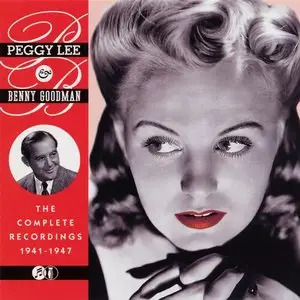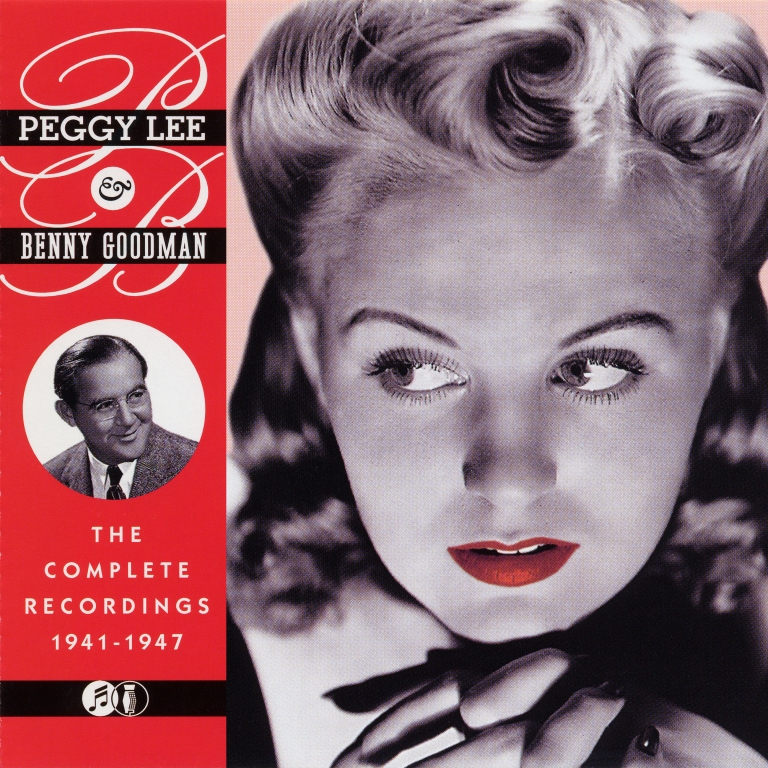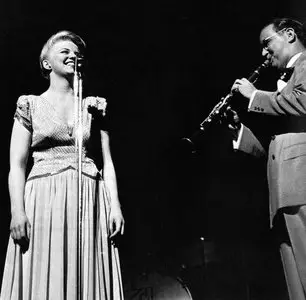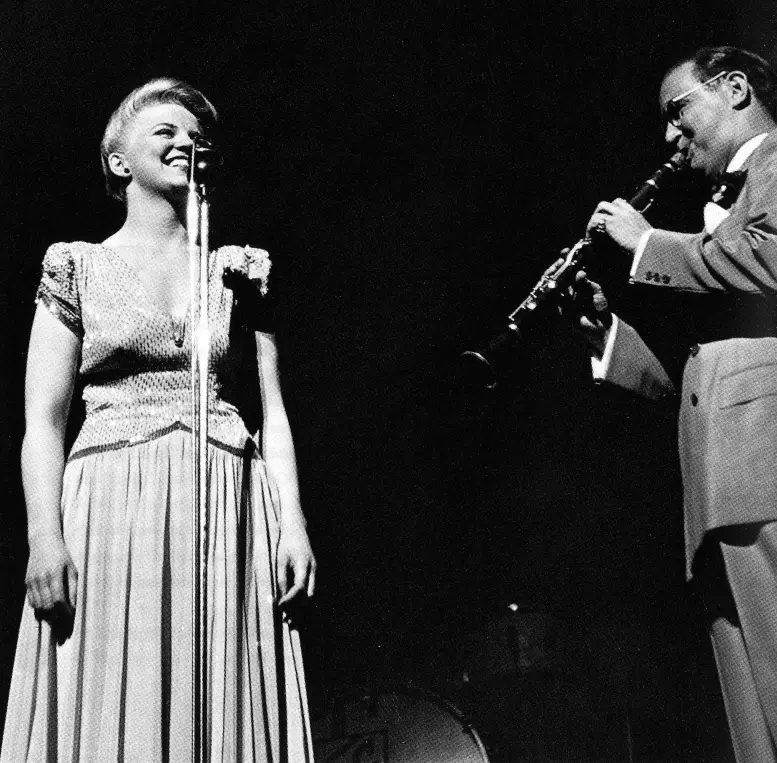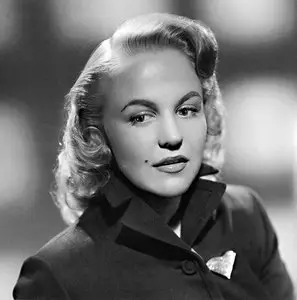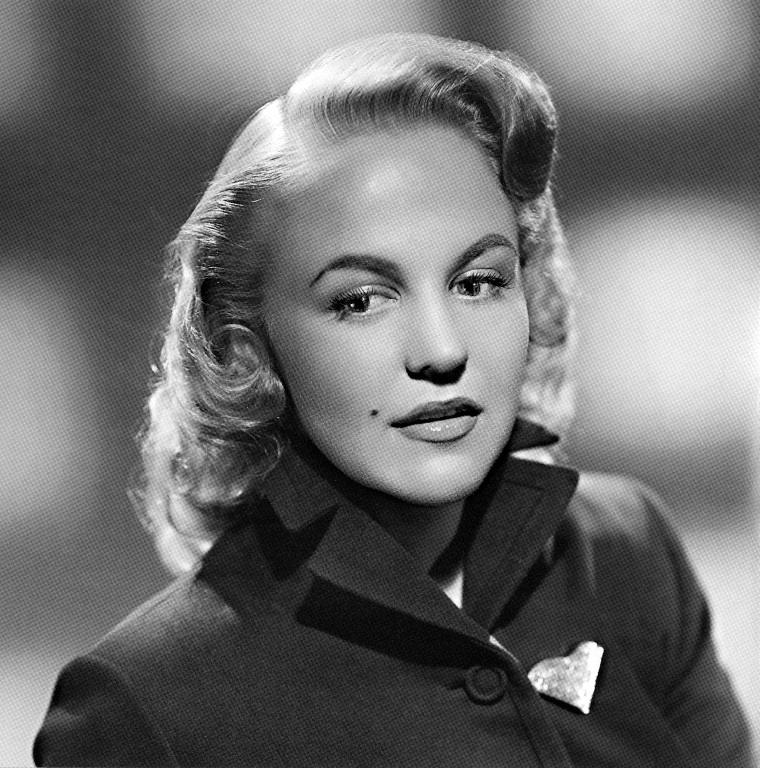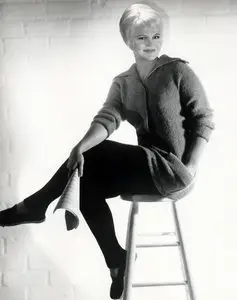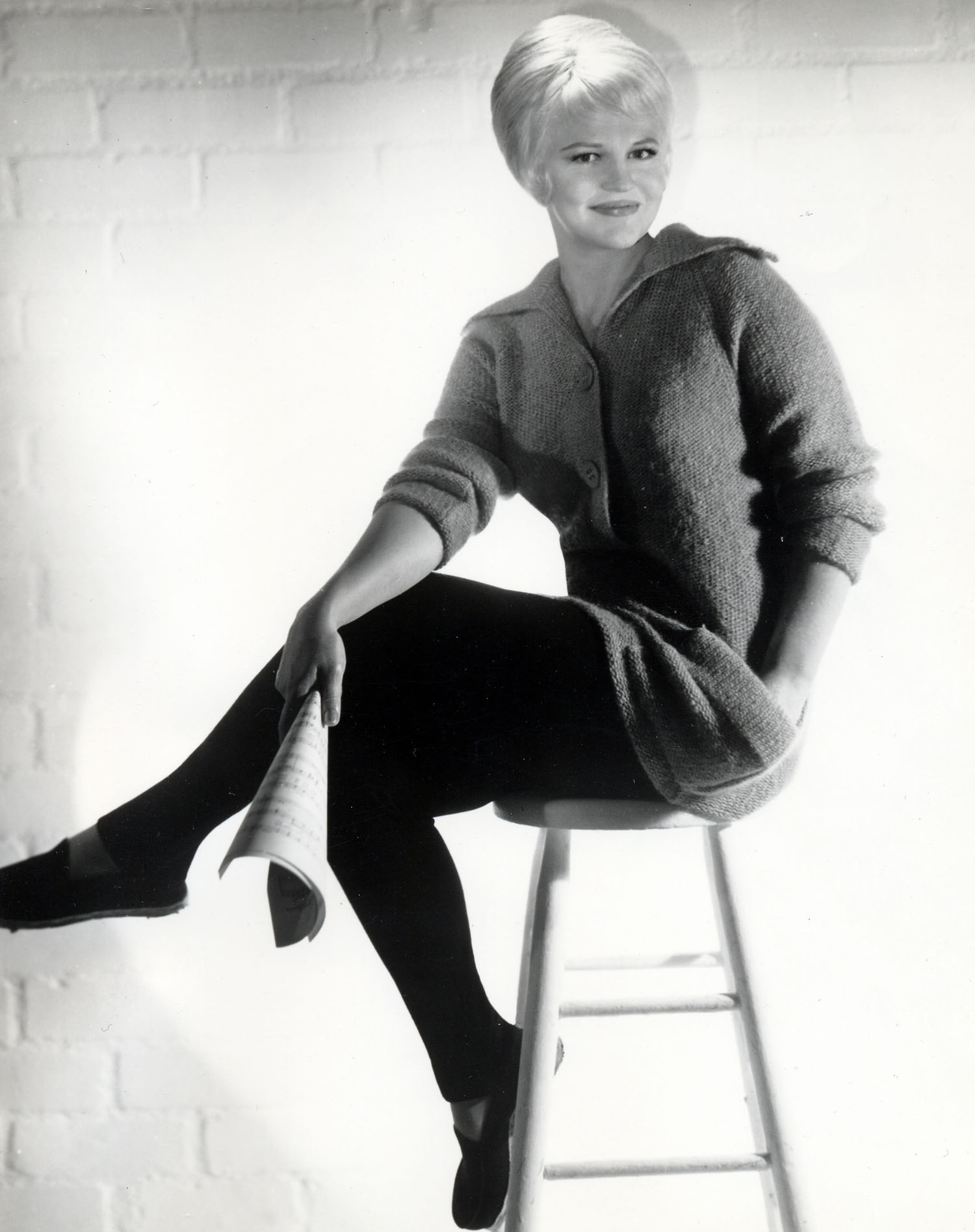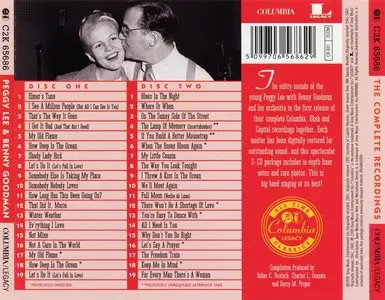Peggy Lee & Benny Goodman - The Complete Recordings 1941-1947 - 1999
WavPack (Img + Cue + Log + Audio Identifier Report Included): 433 Mb | EAC Secure Mode Rip | Mp3 (Fraunhofer IIS - 320 kbps): 367 Mb | HQ Scans | Rar Files (3% Recovery)
Audio CD (June 15, 1999) - Number of Discs: 2 - Format: Original Recording Remastered - Label: Columbia/Legacy - Catalog Number: C2K 65686
Jazz
WavPack (Img + Cue + Log + Audio Identifier Report Included): 433 Mb | EAC Secure Mode Rip | Mp3 (Fraunhofer IIS - 320 kbps): 367 Mb | HQ Scans | Rar Files (3% Recovery)
Audio CD (June 15, 1999) - Number of Discs: 2 - Format: Original Recording Remastered - Label: Columbia/Legacy - Catalog Number: C2K 65686
Jazz
Biography: More than two decades have passed since Peggy Lee sang with Benny Goodman’s swing band and made her first hit recording. Yet so inexhaustible is her talent and so intense her application to her work that, almost a generation later, she stands at the peak of her career. A product of the big-band era, she derived from that apprenticeship her ability to sing anything from jazz to blues, to sing it with a beat, and with enough volume to be heard above the band. Few vocalists have had her staying power. Peggy Lee is also a successful composer, lyricist, arranger, actress, and businesswoman. To all her careers she brings a perfectionism that leaves the stamp of professionalism on everything she touches. Of Norwegian and Swedish ancestry, Peggy Lee was born Norma Deloris Egstrom in Jamestown, North Dakota, a farm town on the Great Plains, on May 26, 1920. She was the seventh of eight children born to Marvin Egstrom, a station agent for the Midland Continental Railroad, and Mrs. Egstrom, who died when the child was four years old. Encouraged by the recognition she had received for her singing with the high school glee club, the church choir, and semi-professional college bands, Norma headed for Hollywood after she graduated from high school in 1938. With her she took $18 in cash and a railroad pass she had borrowed from her father. Although she got a brief singing engagement at the Jade Room, a supper club on Hollywood Boulevard, she made little impression on the film capital, and she was reduced to working as a waitress and as a carnival spieler at a Balboa midway. Deciding to try her luck nearer home, she found work as a singer over radio station WDAY in Fargo, North Dakota, whose manager, Ken Kennedy, christened her Peggy Lee. (To supplement her income she worked for a time as a bread slicer in a Fargo bakery.) Her prospects for a career brightened when she moved to Minneapolis, where she sang in the dining room of the Radisson Hotel, appeared on a Standard Oil radio show, and sang with Sev Olsen’s band. Miss Lee broke into the big time when she became a vocalist with Will Osborne’s band, but three months after she joined the group it broke up in St. Louis, and she got a ride to California with the manager. It was at the Doll House in Palm Springs, California that Peggy Lee first developed the soft and "cool" style that has become her trademark. Unable to shout above the clamor of the Doll House audience, Miss Lee tried to snare its attention by lowering her voice. The softer she sang the quieter the audience became. She has never forgotten the secret, and it has given her style its distinctive combination of the delicate and the driving, the husky and the purringly seductive. One of the members of the Doll House audience was Frank Bering, the owner of Chicago’s Ambassador West Hotel, who invited her to sing in his establishment’s Buttery Room.
Benny Goodman discovered Peggy Lee’s vocalizing in the Buttery Room at a time when he was looking for a replacement for Helen Forrest. Miss Lee joined Goodman’s band in July, 1941, when the band was at the height of its popularity, and for over two years she toured the United States with the most famous swing outfit of the day, playing hotel engagements, college proms, theater dates, and radio programs.
Much of her present success Miss Lee credits to her apprenticeship with the big bands. "I learned more about music from the men I worked with in bands than I’ve learned anywhere else," she has said. "They taught me discipline and the value of rehearsing and even how to train…. Band singing taught us the importance of interplay with musicians. And we had to work close to the arrangement." In July, 1942, Peggy Lee recorded her first smash hit, "Why Don’t You Do Right?" It sold over 1,000,000 copies and made her famous. In March, 1943, Peggy Lee married Dave Barbour, the guitarist in Goodman’s band; shortly thereafter she left the band. After her daughter, Nicki, was born in 1944, Peggy Lee and her husband worked successfully on the West Coast. In 1944 she began to record for Capitol Records, for whom she has produced a long string of hits – many of them with lyrics and music by Miss Lee and Dave Barbour. Among them are "Golden Earrings," which sold over 1,000,000 copies [sic; song not written by Lee and Barbour]; "You Was Right, Baby;" "It’s a Good Day;" "Mañana" (which sold over 2,000,000 records); "What More Can a Woman Do?;" and "I Don’t Know Enough About You." Today Peggy Lee has a top rating as a songwriter with the American Society of Composers, Authors and Publishers. In 1950 Peggy Lee made a first, brief screen appearance [sic; she had previously appeared in "Stage Door Canteen," "The Powers Girl" and several shorts] in Paramount’s "Mr. Music," starring Bing Crosby. In 1953 she played a featured role opposite Danny Thomas in Warner Brothers’ remake of the early Al Jolson talking picture, "The Jazz Singer," and won praise from a critic of the "New York Wolrd-Telegram and Sun" for "a very promising start on a movie career" as "a poised and ingratiating ingenue." Her performance as a despondent and alcoholic blues singer in "Pete Kelly’s Blues" (Warner Brothers, 1955) won her a nomination from the Academy of Motion Picture Arts and Sciences. In the 1955 balloting conducted by the Council of Motion Picture Organizations, moviegoers voted her the "Audie" statuette. Peggy Lee has not only appeared in motion pictures but she has also written music and lyrics for them. She wrote the theme music for "Johnny Guitar" (Republic, 1954) and for "About Mrs. Leslie" (Paramount, 1954). She contributed the musical score to two George Pal cartoon features, "Tom Thumb" (MGM, 1958) and "The Time Machine" (MGM, 1960), and wrote the lyrics and supplied several voices for the Walt Disney full-length animated cartoon "Lady and the Tramp" (Buena Vista, 1955). For "Anatomy of a Murder" (Columbia, 1959) she wrote the lyrics for "I’m Gonna Go Fishin’" to music by Duke Ellington. In the respect she commands from the critics both as a popular vocalist and as a jazz artist, Peggy Lee is a rarity among singers. Critic George Hoefer of "Downbeat" magazine has called her "the greatest white female jazz singer since Mildred Bailey," and Leonard Feather in "The Encyclopedia of Jazz" (Horizon, 1960) has described her as "one of the most sensitive and jazz-oriented singers in the pop field." Miss Lee won the 1946 polls as best female vocalist of both "Metronome" and "Downbeat" magazines, wisely read by jazz buffs, and the 1950 citation as "the nation’s most popular female vocalist" from "Billboard," a trade magazine of show business. A frequent performer on television, she sang on the Thursday night "Revlon Revues" over CBS-TV in 1960, and has appeared on televised musical variety shows starring Perry Como, George Gobel, Steve Allen and Bing Crosby. In March, 1960 she undertook a straight dramatic role in "So Deadly, So Evil" on the "General Electric Theater" over CBS-TV. In September, 1962 Miss Lee reached what she has called the "high spot" in her career when she was selected to appear in Philharmonic Hall of New York’s Lincoln Center for the Performing Arts, an auditorium usually available to those whom the management considers as serious artists. Miss Lee conducted research for, and wrote a program called "The Jazz Tree," tracing the origins and development of jazz as a native American art form. Originally scheduled for December, 1962, the booking was postponed until March, 1963 to give Miss Lee enough time to perfect her presentation. This perfectionist approach to her programs is typical of Miss Lee. She polishes and perfects every aspect of her performances – her special coiffures, her costly wardrobe, her lighting, her entrances and exits, and her musical arrangements. Her perfectionism may derive from her association with Benny Goodman, who always demanded the best from his performers. Rejecting the improvisatory approach of most jazz singers, Peggy Lee plans every detail of her delivery in advance, including even the movement of her hands. This perfectionism has taken its toll of her health on several occasions; she was hospitalized with virus pneumonia in July, 1958 and in November, 1961. As a result, Miss Lee has reduced her schedule, confining her public appearances to six weeks each year in New York and Las Vegas, a few television shows, and one or two charity benefits. Although Miss Lee continues to collaborate with Dave Barbour on words and music, their marriage ended in divorce in 1951. On January 4, 1955, Miss Lee married Brad Dexter, a movie actor. Ten months later they were divorced. Miss Lee’s third marriage, to actor Dewey Martin on April 25, 1956, also ended in divorce in 1959. [A fourth marriage, 1964-1965, was to percussionist and bandleader Jack Del Rio.] She is 5’7" in height, with hazel eyes and champagne-blonde hair. With her daughter, Nicki, she lives in Coldwater Canyon, near Hollywood, California. It contains not only a soundproof studio with tape units, microphones, grand piano, and other equipment for writing and recording music, but also an artist’s studio in which she paints and sculpts the hands of musicians and the heads of great men like Albert Schweitzer whom she admires. A book of her verse, "Softly, With Feeling," was published in 1953. In 1958 Miss Lee consolidated her various activities, which include music publishing firms and a production unit for television and films, into a company called Peggy Lee enterprises. Noted for her generosity, she has been active in such philanthropies as CARE and WAIF, and in November, 1962 was appointed national chairman of the Tom Dooley Foundation. In spite of her many commitments, Peggy Lee makes a point of finding enough time for reading, especially the essays of Ralph Waldo Emerson who, she feels, has a special significance for Americans today. "I wouldn’t still be working today if it weren’t for the strength I’ve derived from some of his essays," she once told Neil Hickey in an interview for "American Weekly" (July 3, 1960). "He said: ‘God will not have his work done by cowards.’ To me that means: ‘Don’t let your personal problems get in the way of your life’s work.’ I’ve had to remember that rule several times during my career.
Product Description: Digitally remastered by Darcy M. Proper (Sony Music Studios, New York, New York). Recording information: 10/02/1941-12/02/1947. These 38 tracks chronicle Peggy Lee's first recordings of her long and productive career, and chart her musical evolution, from rather timid, run-of-the-mill band singer to sophisticated and confident performer. Her first records, like "Elmer's Tune," reveal a pretty voice, but with little trace of the character and charisma that was to surface in later sessions. These standard vocal refrains are buoyed by Benny Goodman's exciting aggregation and Mel Powell's ebullient arrangements. Rhythmically in sync with the powerful band, Lee finds her footing in songs like "That Did it, Marie." Increasingly relaxed, she handles the unrelenting tempos beautifully, and by "Sunny Side of the Street" and "Why Don't You Do Right," her blues-infused interpretations are pointing the way to a style that would later make her the queen of hip.
In 1941, Peggy Lee had just come down from her home state of North Dakota to join Benny Goodman's band in Chicago as a replacement for Helen Forrest. Lee was young, frightened, and forced to sing the band's songs in Forrest's keys. No surprise, then, that the earliest records in this anthology seem a bit stiff and without commitment. She had not yet narrowed her range nor begun to phrase behind the beat (both á la Billie Holiday), but the confidence and speed with which she began to form her style are documented here, and it's amazing to hear how quickly she advanced–keep in mind that all but three of these recordings were made in a one year period between 1941 and 1942. And even when her singing lacks interest, there are some stunning arrangements here by Eddie Sauter and Mel Powell. After six months with the band, Lee was flying: the second CD contains gems such as "Where or When" and "The Way You Look Tonight" with the Goodman trio; her hit cover of Lil Green's "Why Don't You Do Right"; a couple of duos with Johnny Mercer; and three songs from a little-known reunion with Goodman in 1947. By then she was on her own, the Holiday influence was fully assimilated, and her smoky, vibrato-less voice was assured and distinct.
Review: If you THINK you know Peggy Lee, get this incredible collection. The singer with Benny Goodman's Orchestra is quite different from the hit-record maker who came later. Here she's a high, high soprano very wedded to the tempo and so passive she's spooky. It was written that her rendition of "How Deep Is The Ocean" (which reverses the first two verses, incidentally) is like a moon crossing a cloudless sky, silent, steady but oh so hypnotically entrancing. Oh, so true. These recordings absolutely crawl right under your skin. You will listen and listen and listen trying to uncover the unsolvable mystery of just what is going on vocally here and why it is so deeply moving while seemingly so incredibly simple. The Lee who came out of this Lee–the later Lee who is so stylish, perfect, witty, subtle–is a whole different singer but even Peg must appreciate these recordings and how she began. ~ Amazon Customer
Disc 1
01 - Elmer's Tune - 2:53
02 - I See A Million People (But All I Can See Is You) - 2:44
03 - That's The Way It Goes - 3:11
04 - I Got It Bad And That Ain't Good - 3:18
05 - My Old Flame - 3:11
06 - How Deep Is The Ocean - 3:07
07 - Shady Lady Bird - 2:48
08 - Let's Do It (Let's Fall In Love) - 2:19
09 - Somebody Else Is Taking My Place - 3:11
10 - Somebody Nobody Loves - 3:23
11 - How Long Has This Been Going On - 3:18
12 - That Did It, Marie - 2:32
13 - Winter Weather - 3:03
14 - Ev'rything I Love - 3:07
15 - Not Mine - 3:20
16 - Not A Care In The World - 3:27
17 - My Old Flame - 3:18
18 - How Deep Is The Ocean - 3:23
19 - Let's Do It (Let's Fall In Love) - 2:02
Disc 2
01 - Blues In The Night - 3:17
02 - Where Or When - 3:23
03 - On The Sunny Side Of The Street - 3:13
04 - The Lamp Of Memory (Incertidumbre) - 3:20
05 - If You Build A Better Mousetrap - 3:05
06 - When The Roses Bloom Again - 2:55
07 - My Little Cousin - 3:20
08 - The Way You Look Tonight - 3:20
09 - I Threw A Kiss In The Ocean - 3:03
10 - We'll Meet Again - 3:20
11 - Full Moon (Noche de Luna) - 3:20
12 - There Won't Be A Shortage Of Love - 2:43
13 - You're Easy To Dance With - 3:18
14 - All I Need Is You - 3:25
15 - Why Don't You Do Right - 3:15
16 - Let's Say A Prayer - 3:18
17 - The Freedom Train - 3:13
18 - Keep Me In Mind - 2:57
19 - For Every Man There's A Woman - 2:47
Personnel:
Peggy Lee (vocals); Benny Goodman (clarinet); Mel Powell (arranger, piano); Eddie Sauter (arranger); Skippy Martin, Clint Neagley (alto saxophone); Vido Musso (tenor saxophone); Charles Gentry (baritone saxophone); Billy Butterfield, Cootie Williams, Jimmy Maxwell, Al Davis, Bernie Privin (trumpet); Lou McGarity, Cutty Cutshall (trombone); Red Norvo (vibraphone); Tom Morgan (guitar); John Simmons (bass); Sid Catlett, Alvin Stoller (drums); Johnny Mercer & The Pied Pipers; Paul Weston and his Orchestra.
guaza
If you discover any dead links in any of my posts,
Please Send Me a Private Message !!!!
Please Send Me a Private Message !!!!
Exact Audio Copy V0.99 prebeta 5 from 4. May 2009
EAC extraction logfile from 3. February 2010, 20:03
Peggy Lee & Benny Goodman / The Complete Recordings 1941 - 1947 - CD 1
Used drive : Pioneer BDR-203BK Adapter: 8 ID: 0
Read mode : Secure
Utilize accurate stream : Yes
Defeat audio cache : Yes
Make use of C2 pointers : No
Read offset correction : 667
Overread into Lead-In and Lead-Out : No
Fill up missing offset samples with silence : Yes
Delete leading and trailing silent blocks : No
Null samples used in CRC calculations : Yes
Used interface : Native Win32 interface for Win NT & 2000
Used output format : User Defined Encoder
Selected bitrate : 128 kBit/s
Quality : High
Add ID3 tag : No
Command line compressor : C:\WINDOWS\system32\wavpack-4.60.1\wavpack.exe
Additional command line options : -hmx3 -w "Year=%y" -w "Genre=%m" %s %d
TOC of the extracted CD
Track | Start | Length | Start sector | End sector
––––––––––––––––––––––––––––-
1 | 0:00.00 | 2:53.12 | 0 | 12986
2 | 2:53.12 | 2:43.69 | 12987 | 25280
3 | 5:37.06 | 3:11.03 | 25281 | 39608
4 | 8:48.09 | 3:17.72 | 39609 | 54455
5 | 12:06.06 | 3:10.63 | 54456 | 68768
6 | 15:16.69 | 3:07.01 | 68769 | 82794
7 | 18:23.70 | 2:47.72 | 82795 | 95391
8 | 21:11.67 | 2:19.04 | 95392 | 105820
9 | 23:30.71 | 3:11.15 | 105821 | 120160
10 | 26:42.11 | 3:22.60 | 120161 | 135370
11 | 30:04.71 | 3:17.72 | 135371 | 150217
12 | 33:22.68 | 2:31.72 | 150218 | 161614
13 | 35:54.65 | 3:03.01 | 161615 | 175340
14 | 38:57.66 | 3:07.04 | 175341 | 189369
15 | 42:04.70 | 3:19.72 | 189370 | 204366
16 | 45:24.67 | 3:27.00 | 204367 | 219891
17 | 48:51.67 | 3:18.34 | 219892 | 234775
18 | 52:10.26 | 3:22.57 | 234776 | 249982
19 | 55:33.08 | 2:01.60 | 249983 | 259117
Range status and errors
Selected range
Filename O:\-=Music 4\Jazz\Peggy Lee\Peggy Lee & Benny Goodman - The Complete Recordings 1941-1947 - 1999\ydtEyy8s\Disc 1\Peggy Lee & Benny Goodman - The Complete Recordings 1941 - 1947 - CD 1.wav
Peak level 100.0 %
Range quality 100.0 %
Copy CRC 8D5C3FA0
Copy OK
No errors occurred
End of status report
EAC extraction logfile from 3. February 2010, 20:03
Peggy Lee & Benny Goodman / The Complete Recordings 1941 - 1947 - CD 1
Used drive : Pioneer BDR-203BK Adapter: 8 ID: 0
Read mode : Secure
Utilize accurate stream : Yes
Defeat audio cache : Yes
Make use of C2 pointers : No
Read offset correction : 667
Overread into Lead-In and Lead-Out : No
Fill up missing offset samples with silence : Yes
Delete leading and trailing silent blocks : No
Null samples used in CRC calculations : Yes
Used interface : Native Win32 interface for Win NT & 2000
Used output format : User Defined Encoder
Selected bitrate : 128 kBit/s
Quality : High
Add ID3 tag : No
Command line compressor : C:\WINDOWS\system32\wavpack-4.60.1\wavpack.exe
Additional command line options : -hmx3 -w "Year=%y" -w "Genre=%m" %s %d
TOC of the extracted CD
Track | Start | Length | Start sector | End sector
––––––––––––––––––––––––––––-
1 | 0:00.00 | 2:53.12 | 0 | 12986
2 | 2:53.12 | 2:43.69 | 12987 | 25280
3 | 5:37.06 | 3:11.03 | 25281 | 39608
4 | 8:48.09 | 3:17.72 | 39609 | 54455
5 | 12:06.06 | 3:10.63 | 54456 | 68768
6 | 15:16.69 | 3:07.01 | 68769 | 82794
7 | 18:23.70 | 2:47.72 | 82795 | 95391
8 | 21:11.67 | 2:19.04 | 95392 | 105820
9 | 23:30.71 | 3:11.15 | 105821 | 120160
10 | 26:42.11 | 3:22.60 | 120161 | 135370
11 | 30:04.71 | 3:17.72 | 135371 | 150217
12 | 33:22.68 | 2:31.72 | 150218 | 161614
13 | 35:54.65 | 3:03.01 | 161615 | 175340
14 | 38:57.66 | 3:07.04 | 175341 | 189369
15 | 42:04.70 | 3:19.72 | 189370 | 204366
16 | 45:24.67 | 3:27.00 | 204367 | 219891
17 | 48:51.67 | 3:18.34 | 219892 | 234775
18 | 52:10.26 | 3:22.57 | 234776 | 249982
19 | 55:33.08 | 2:01.60 | 249983 | 259117
Range status and errors
Selected range
Filename O:\-=Music 4\Jazz\Peggy Lee\Peggy Lee & Benny Goodman - The Complete Recordings 1941-1947 - 1999\ydtEyy8s\Disc 1\Peggy Lee & Benny Goodman - The Complete Recordings 1941 - 1947 - CD 1.wav
Peak level 100.0 %
Range quality 100.0 %
Copy CRC 8D5C3FA0
Copy OK
No errors occurred
End of status report
Exact Audio Copy V0.99 prebeta 5 from 4. May 2009
EAC extraction logfile from 3. February 2010, 20:11
Peggy Lee & Benny Goodman / The Complete Recordings 1941 - 1947 (Disc 2)
Used drive : Pioneer BDR-203BK Adapter: 8 ID: 0
Read mode : Secure
Utilize accurate stream : Yes
Defeat audio cache : Yes
Make use of C2 pointers : No
Read offset correction : 667
Overread into Lead-In and Lead-Out : No
Fill up missing offset samples with silence : Yes
Delete leading and trailing silent blocks : No
Null samples used in CRC calculations : Yes
Used interface : Native Win32 interface for Win NT & 2000
Used output format : User Defined Encoder
Selected bitrate : 128 kBit/s
Quality : High
Add ID3 tag : No
Command line compressor : C:\WINDOWS\system32\wavpack-4.60.1\wavpack.exe
Additional command line options : -hmx3 -w "Year=%y" -w "Genre=%m" %s %d
TOC of the extracted CD
Track | Start | Length | Start sector | End sector
––––––––––––––––––––––––––––-
1 | 0:00.00 | 3:17.31 | 0 | 14805
2 | 3:17.31 | 3:23.00 | 14806 | 30030
3 | 6:40.31 | 3:13.00 | 30031 | 44505
4 | 9:53.31 | 3:20.00 | 44506 | 59505
5 | 13:13.31 | 3:05.00 | 59506 | 73380
6 | 16:18.31 | 2:55.00 | 73381 | 86505
7 | 19:13.31 | 3:20.00 | 86506 | 101505
8 | 22:33.31 | 3:20.04 | 101506 | 116509
9 | 25:53.35 | 3:03.00 | 116510 | 130234
10 | 28:56.35 | 3:20.00 | 130235 | 145234
11 | 32:16.35 | 3:20.03 | 145235 | 160237
12 | 35:36.38 | 2:43.00 | 160238 | 172462
13 | 38:19.38 | 3:18.00 | 172463 | 187312
14 | 41:37.38 | 3:25.00 | 187313 | 202687
15 | 45:02.38 | 3:15.00 | 202688 | 217312
16 | 48:17.38 | 3:17.60 | 217313 | 232147
17 | 51:35.23 | 3:13.21 | 232148 | 246643
18 | 54:48.44 | 2:57.37 | 246644 | 259955
19 | 57:46.06 | 2:46.46 | 259956 | 272451
Range status and errors
Selected range
Filename O:\-=Music 4\Jazz\Peggy Lee\Peggy Lee & Benny Goodman - The Complete Recordings 1941-1947 - 1999\ydtEyy8s\Disc 2\Peggy Lee & Benny Goodman - The Complete Recordings 1941 - 1947 (Disc 2).wav
Peak level 99.9 %
Range quality 100.0 %
Copy CRC 4703CEFC
Copy OK
No errors occurred
End of status report
EAC extraction logfile from 3. February 2010, 20:11
Peggy Lee & Benny Goodman / The Complete Recordings 1941 - 1947 (Disc 2)
Used drive : Pioneer BDR-203BK Adapter: 8 ID: 0
Read mode : Secure
Utilize accurate stream : Yes
Defeat audio cache : Yes
Make use of C2 pointers : No
Read offset correction : 667
Overread into Lead-In and Lead-Out : No
Fill up missing offset samples with silence : Yes
Delete leading and trailing silent blocks : No
Null samples used in CRC calculations : Yes
Used interface : Native Win32 interface for Win NT & 2000
Used output format : User Defined Encoder
Selected bitrate : 128 kBit/s
Quality : High
Add ID3 tag : No
Command line compressor : C:\WINDOWS\system32\wavpack-4.60.1\wavpack.exe
Additional command line options : -hmx3 -w "Year=%y" -w "Genre=%m" %s %d
TOC of the extracted CD
Track | Start | Length | Start sector | End sector
––––––––––––––––––––––––––––-
1 | 0:00.00 | 3:17.31 | 0 | 14805
2 | 3:17.31 | 3:23.00 | 14806 | 30030
3 | 6:40.31 | 3:13.00 | 30031 | 44505
4 | 9:53.31 | 3:20.00 | 44506 | 59505
5 | 13:13.31 | 3:05.00 | 59506 | 73380
6 | 16:18.31 | 2:55.00 | 73381 | 86505
7 | 19:13.31 | 3:20.00 | 86506 | 101505
8 | 22:33.31 | 3:20.04 | 101506 | 116509
9 | 25:53.35 | 3:03.00 | 116510 | 130234
10 | 28:56.35 | 3:20.00 | 130235 | 145234
11 | 32:16.35 | 3:20.03 | 145235 | 160237
12 | 35:36.38 | 2:43.00 | 160238 | 172462
13 | 38:19.38 | 3:18.00 | 172463 | 187312
14 | 41:37.38 | 3:25.00 | 187313 | 202687
15 | 45:02.38 | 3:15.00 | 202688 | 217312
16 | 48:17.38 | 3:17.60 | 217313 | 232147
17 | 51:35.23 | 3:13.21 | 232148 | 246643
18 | 54:48.44 | 2:57.37 | 246644 | 259955
19 | 57:46.06 | 2:46.46 | 259956 | 272451
Range status and errors
Selected range
Filename O:\-=Music 4\Jazz\Peggy Lee\Peggy Lee & Benny Goodman - The Complete Recordings 1941-1947 - 1999\ydtEyy8s\Disc 2\Peggy Lee & Benny Goodman - The Complete Recordings 1941 - 1947 (Disc 2).wav
Peak level 99.9 %
Range quality 100.0 %
Copy CRC 4703CEFC
Copy OK
No errors occurred
End of status report


